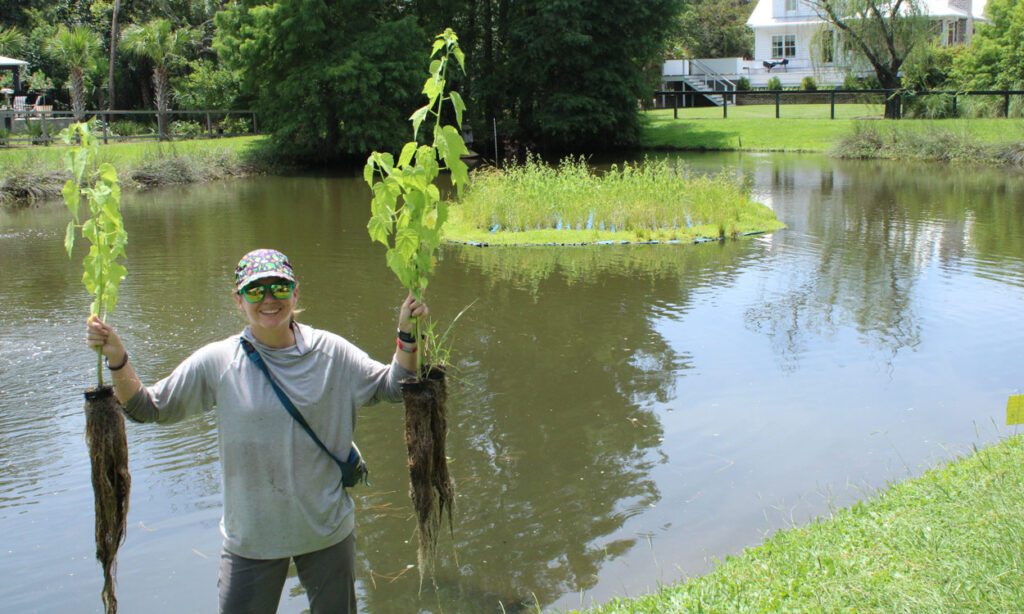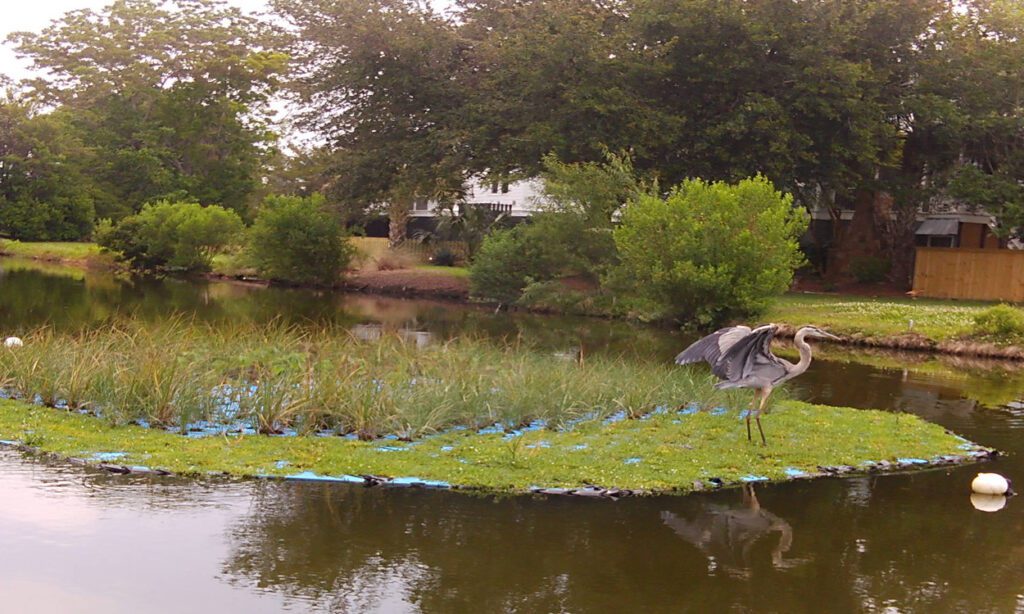
Soon after receiving her master’s degree from Texas A&M University, Clare Escamilla began working for the Texas Water Resources Institute where her work mainly focused on surface water quality.
It wasn’t long after starting her new job that Escamilla learned that Clemson University was looking for a doctoral student to assist Sarah White, professor of water quality and treatment, and Amy Scaroni, assistant professor of watershed management, in their research on water quality improvement.
“They wanted to have a strong Extension component and using floating wetlands, which is not something that I had worked on previously,” Escamilla said. “It seemed like a perfect opportunity for me to be able to dive in and explore this kind of realm a little more and develop those skills.”
Escamilla did that – and then some, in many ways exceeding the expectations of both White and Scaroni. The Summit, New Jersey native will receive her doctorate this summer from the Department of Plant and Environmental Sciences before heading to her new job at Utah State University as an assistant professor and water quality specialist.
“It has been a true joy to work with Clare,” Scaroni said. “She has been an outstanding student (and human) in every way. She is curious, inquisitive, collaborative and resourceful; she demonstrates significant leadership skills and is a great supporter and cheerleader of others.

“Clare has a great sense of humor and does an admirable job of remaining positive, even under difficult circumstances. She was my first Ph.D. student and has set an extremely high bar for those who will follow her. Her dedication and determination carried her through an intensive research project and she deserves all the many accolades and recognition she has received along the way.”
Escamilla’s research centered on floating treatment wetlands and using them in brackish stormwater ponds to help improve water quality while also meeting the needs of residents. One of her goals was to be sure to include the residents’ input in her floating wetlands designs.
Escamilla held focus groups. From there, she developed an online survey for the residents to figure out what was important to them regarding their stormwater ponds and to gauge their initial thoughts on floating wetlands.
“Honestly, I was surprised how open people were to talk to us,” Escamilla said. “It seemed like people really cared. It became pretty apparent these ponds are very prominent features in these residential neighborhoods. A lot of people like to go out there and view wildlife. They walk their dogs around it. Some of them fish in it. They hold a lot of value to it. They definitely had a lot of opinions about their ponds and what they wanted in and out of the pond.”
Typically, designs for floating wetlands were solely based on using plants that were going to uptake the most nutrients and provide the best water quality benefits, Escamilla said. But after learning the residents cared about the aesthetics of the project, she had to be more intentional about her designs. She chose plants that flowered and added a pop of color, had different heights and textures and were visually appealing, while also improving the water quality.
Another variable she encountered was because the ponds were in coastal areas, they were more brackish with varying salinity levels. She had to screen the plants to determine which ones would work best under those conditions.

“That’s something my advisors had heard before is people would try to install floating wetlands and the plants would just die and you wouldn’t get any benefit from them,” Escamilla said. “I took what I learned from them and tried to screen a variety of plants that hopefully would reach our goals for water quality but also have those design elements that we want and could survive some of these salinity levels that we see in ponds.”
Once floating wetlands were installed, Escamilla said the feedback she received was that the residents liked how the wetlands looked and they enjoyed the wildlife they were now able to view, such as turtles basking on the floating wetlands and ducks nesting. There were even reports of an alligator sunning on one of the floating wetlands.
To help residents maintain the floating wetlands, Escamilla and Scaroni developed a floating wetlands maintenance fact sheet housed on the Clemson Home and Garden Information Center’s website. They are also in the process of creating a manual to help people maintain their floating wetlands so they can “keep it in a way that is a benefit for the pond but also for the community.”
Maintaining the water quality for nutrients is one of the key benefits of having floating wetlands in stormwater ponds.

“A lot of these stormwater ponds get runoff from the surrounding landscapes so that can bring pet waste that’s not disposed of properly. If people are overusing fertilizer it can bring in potential sources of nutrients, and when it gets really high, that can lead to algal blooms,” Escamilla said. “That can discharge into your surrounding coastal water bodies. When you have lower oxygen levels, it can lead to fish kill or just bad odors.”
During her time at Clemson, Escamilla received a second-place award in the 2024 Graduate Symposium Ph.D. poster competition for her work titled “Finding the right plants for floating wetlands deployed in brackish, coastal towns.” At the 2023 symposium, she won first place for her Three-Minute Thesis.
“Clare is the consummate professional in everything in which she engaged,” White said. “It is rare for a graduate student to publish their research while still completing their work, but Clare published two articles and had submitted another two even before she defended her dissertation. She is incredibly gifted in how she engages with the communities where her floating wetlands were installed.
“Clare conducted some of the first of its kind work related to screening plants for salt tolerance and potential for use in floating wetlands in brackish stormwater ponds in urban communities. Her research also provided valuable insight into the traits of floating wetlands that make them attractive to communities where they can be used. These insights help us tailor floating wetland design choices, so they accomplish the water quality goal while also meeting community aesthetic preferences.”

Escamilla is excited to begin her new role at Utah State. As an assistant professor/water quality specialist, 60% of her work will be in Extension, 30% teaching and 10% providing professional services.
“I’m excited about the opportunity because it’s a lot of what I’m interested in doing,” she said. “It’s a completely new area so it’s going to be a little bit of a learning curve to learn what the priorities are in Utah, but I’m excited.”
“I have no doubt that Clare will excel at Utah State,” Scaroni said. “She has found a great home in the Department of Watershed Sciences and I can’t wait to see how her research and Extension portfolio develops. She is a skilled science communicator who will have no trouble finding novel ways to translate research results to communities across Utah. I look forward to seeing what types of creative outreach programs she develops and possibly borrowing some of her ideas to replicate in South Carolina.”
Get in touch and we will connect you with the author or another expert.
Or email us at news@clemson.edu
